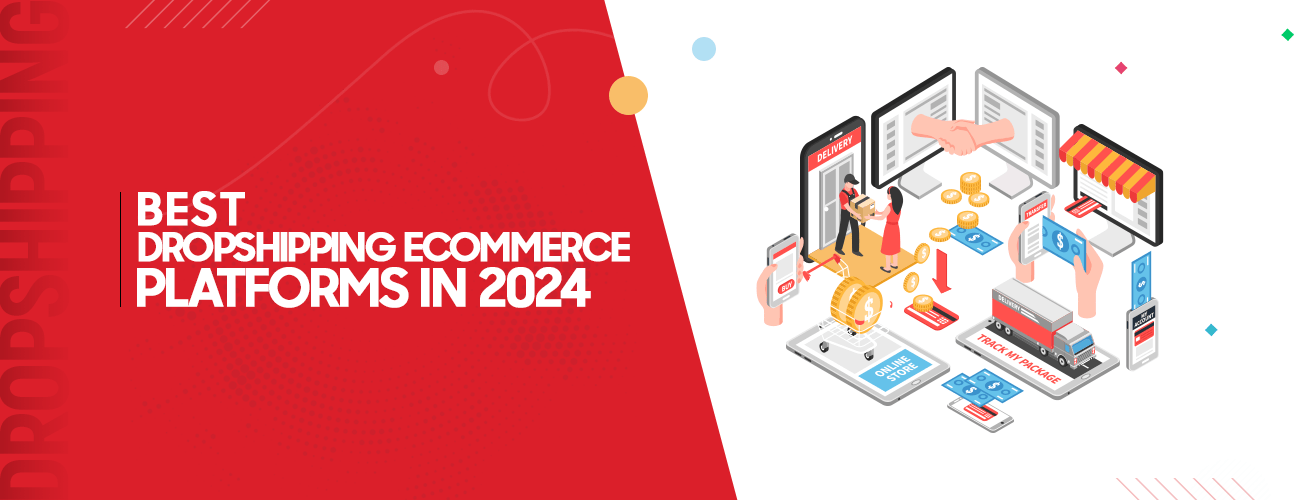Best Dropshipping Ecommerce Platforms in 2024
Dropshipping has become a preferred model for entrepreneurs who want to test the turbulent water of eCommerce first and launch their eCommerce journey with small capital. Dropshipping, at face value, appears quite simple; you don’t need to bother about inventory warehouses or the linked issues; third-party vendors do the tasks. But it is not as simple as it looks. There are many technical hurdles, unknown risks, and market uncertainties that you have to face.
Of all the challenges that you will need to overcome, selecting the best dropshipping platform is the most daunting one. No matter whether you are a seasoned eCommerce entrepreneur or a newbie looking to just dip your toes in the vast oceans of eCommerce, navigating the market offering countless platforms and selecting the best dropshipping eCommerce platform is not an easy job. Fear not!
The goal of this blog is to equip you with the right understanding and know-how to find the best option. We have done extensive research, gone through countless web pages, and spent hours upon hours coming up with the top eCommerce platforms that you can choose from.
Ready?
Let’s get started!
But first, we look at what features you should look into for the best dropshipping platform.
Best Features to Look into in a Best Dropshipping eCommerce Platform:
As it has been mentioned earlier, running a successful Dropshipping business, a feature-rich eCommerce platform is the first precondition. Here are some key features that businesses look for before making a final decision.
-
Dropshipping Integration:
Integration is an important feature that you should look into. A good platform must provide easy and convenient integration with top-quality suppliers across the world that offer Dropshipping services. Integration can help you find a good supplier and thus provide high-quality products at your Dropshipping store.
For instance, you can easily integrate your Dropshipping store with WooCommerce like Spocket, AliDropship, and more.
-
Customer Services:
eCommerce platforms can face problems. There is nothing in the eCommerce world that is 100% perfect. You need troubleshooting, resolution of technical hiccups, or any related issue.
Therefore, it is important to select an eCommerce platform that has active and easily accessible customer services. The community of that platform should also be vibrant to give readily available support and guidance.
-
Customization:
You will need customization to develop your brand identity and meet the specific requirements of a niche. Therefore, choose a platform while giving serious consideration to customization features.
It should be noted that some eCommerce platforms such as Shopify offer fewer customization options and others such as Magento provide rich customization features. Make a selection as per your needs.
-
Ease of Use:
The eCommerce Dropshipping platform should be easy to use and navigate. You will have to manage front-end and back-end as a store owner. This necessitates the platform to offer a user-friendly and intuitive interface.
In this regard, some platforms such as WooCommerce, a plugin of WordPress, are extremely easy even for beginners, the same is the case with Shopify. So, make your decision while keeping ease of use in mind.
-
Marketing Tools:
Marketing is key to success in the eCommerce business. Your store must appear prominently in Search Engine Result Pages (SERPs). The platform must offer marketing and SEO tools to help you discover and target the broader audience.
Some platforms such as Shopify have built-in support for SEO tools, for instance, SEO Suite, SEO Booster, and more.
Do consider these marketing capabilities in mind while making the decision.
-
Competitive Pricing:
The dropshipping business is now an overcrowded marketplace. The profit margin has become low with the arrival of countless competitors in the market. It means that you should give serious thought to the price of an eCommerce platform.
Some platforms such as Shopify are comparatively costlier options. It can cost you even higher when you scale up. On the other hand, WooCommerce is extremely free to set up and run a Dropshipping business. But higher pricing comes with more advanced customization features and vice versa. Therefore, eCommerce Dropshipping platforms should be selected after thoroughly analyzing pricing and the upfront cost of installing and using them.
Having discussed some key features that must be there in your e-commerce platform, now we move to the next part of our blog: highlighting the pros and cons of some popular e-commerce platforms.
Shopify:
With 2.1 million merchants worldwide, who engage in more than $440 billion worth of economic activity collectively in 2023, Shopify is undoubtedly the best Dropshipping platform. What’s more, Shopify Oberlo integration in 2006 has made product import and order fulfillment extremely effortless job.
Here are some cons and pros of Shopify Dropshipping.
Pros of Shopify:
- Shopify offers a variety of themes, applications, and features that help you customize your Dropshipping store. There are more than 6000 apps in the store, offering you to manage sales, marketing, design, inventory management, and more.
- Shopify can rightly pride itself on offering industry-leading customer services. The support services are of two types: human support and online resources, allowing you to innovate constantly and resolve all possible issues.
- This eCommerce platform supports selling every kind of product. You can sell physical products, bundled products, subscriptions, consultations, digital productions, live streams, online classes, and more.
- The built-in security of Shopify is also matchless. SSL certification, two-factor authentication, and secure hosting with level 1 PCI compliance are cutting-edge and robust security features.
- The payment processing support of Shopify is incredible. It offers more than 100 solutions, unlike one or two payment gateway solutions, for instance, Amazon Pay, 2Checkout, Shopify Payments, Authorize.net, BitPay, and more.
Cons of Shopify:
Here are some flipsides of Shopify to give you a complete picture.
- As a SaaS (Software as a service) provider, Shopify charges you a fee for using its services and products. In addition, the fee is reoccurring, you have to pay the fee as long as you continue to run the Dropshipping business on Shopify.
- Shopify charges a fee for non-Shopify payment options. This may increase the cost of business as you have to pay a third-party transaction fee.
- Shopify initially offered a lot of free themes, but it does not offer many free theme options. Both premium and standard themes have seen steep rises in the price. But these are one-time payments, you can easily cover that price when sales start to pick up.
- Similarly, installing applications to compensate for certain eCommerce features of Shopify can be expensive, enhancing the costs of doing Dropshipping business.
WooCommerce:
WooCommerce is one of the most widely used eCommerce platforms, powering more than 27.78% of all online stores functional on the internet. But like every platform, WooCommerce Dropshipping has also some distinct advantages and disadvantages.
Advantages of WooCommerce:
- Seamless integration with WordPress is one of the biggest advantages of using WooCommerce for Dropshipping. Therefore, this feature enables the IT team familiar with WordPress to manage and set up an online store.
- Customization of WooCommerce is also top-notch. It supports various free and premium themes and plug-ins to customize Dropshipping online stores as per your unique needs.
- WooCommerce has built-in marketing and SEO tools, allowing you to rank your online store higher on SERPs.
- Like Shopify, WooCommerce has a very vibrant and large community, helping you find solutions hindering your Dropshipping business.
Disadvantages of WooCommerce:
- WooCommerce requires WordPress hosting. It leads not only to increased costs but causes dependency issues as well. Any issues with the installation or setting up of WordPress would hurt the WooCommerce-based online store as well.
- Maintenance of WooCommerce is another big issue. You have to update themes, plug-ins, and WordPress itself to keep the online store working as per its optimal potential.
- Security is also a serious concern. Though both WooCommerce and WordPress regulate updates to remove any security vulnerabilities, users should remain vigilant and continue updating their online stores.
Magento:
Magento is a PHP-based eCommerce platform, offering a higher degree of customization, flexibility, and scalability. Magento is especially popular among mid-sized and large organizations.
Like any other Dropshipping eCommerce platform, Magento also offers pros and cons, discussed below for your help.
Pros of Using Magento:
- Magento is highly flexibility and offers limitless customization options, allowing you to adjust it for your unique needs.
- Magento’s API Architecture allows Dropshipping online store owners to integrate their stores with third-party systems such as CRM, ERP, and more.
- The feature list of Magento is quite extensive. Multiple store views, intuitive admin panel, multi-language support, support for wide-ranging product types, and powerful SEO tools are some of the many features that Magento offers.
- The scalability of Magento is also optimal. No matter whether you are selling 100 items or thousands of SKUs, Magento can help you handle them quite effortlessly.
Cons of Magento as a Dropshipping Platform:
- The biggest drawback of Magento is the high cost of development in comparison with SaaS-based platforms like Shopify and BigCommerce. You will need to dedicate a significant amount of budget for Magento custom development and maintenance.
- A steep learning curve also makes Magento unsuitable for small-sized and startup Dropshipping businesses. Over 20,000 files and 200 database tables of Magento can even confuse a skilled Magento developer, let alone a beginner.
- Magento also demands a powerful hosting platform. You need to host it on a VPS, cloud, or dedicated server. Taking care of domain registration, SSL security certification, and hosting plans are also added sources of concern for your Magento team. All leads to increased costs.
Oberlo Dropshipping:
Oberlo is a popular Dropshipping application or tool for Shopify that helps you set up and run an online store without any need to deal with inventory, packaging, and shipping. This platform helps Dropshipping businesses find and sell millions of products from AliExpress and other and other suppliers.
Like other eCommerce Dropshipping platforms, Oberlo also offers many advantages. For instance, it helps you customize product listings, automate the order fulfillment process, and track inventory from a centralized dashboard. What’s more, Oberlo provides free courses, guides, and tools to help you run a successful Dropshipping business.
Even though Oberlo is an important marketplace for starting a Dropshipping business, how you can use Oberlo? Let’s answer this question.
How to Use Oberlo for Dropshipping:
Oberlo has been designed primarily to integrate with Shopify. Here are some steps that will help you use Oberlo to streamline your Dropshipping business.
Step#1: Integrate Your Online Store with Oberlo:
If you are using Shopify as your eCommerce Dropshipping platform, Oberlo can be integrated easily with Shopify. It is very simple.
- Open the Shopify store, search for Oberlo
- Click “Add App” to install the Oberlo application within your Shopify store.
- After authorization from Oberlo to access your Shopify account, a new dashboard will automatically appear, allowing you to find and import products.
Step#2: Add Products to Your Online Store:
- Use the search function in the dashboard to find and import products.
- After you have found a suitable product, click on “Add to Import List” to import it to your Dropshipping store.
- Now you can customize details of products such as pricing, images, and descriptions to add your particular aesthetic value and ensure Search engine Optimization (SEO).
Step#3: Managing the Store and Fulfilling the Orders:
- You can now consult the Oberlo dashboard about the order details.
- After confirmation, Oberlo communicates directly to the suppliers to fulfill the orders.
- You can track shipments to ensure that the order is delivered within the given timeframe.
Best Oberlo alternatives:
Though Oberlo is a good choice to streamline your Dropshipping business, there are some alternatives to Oberlo as well to help you improve various business processes. For instance:
- Sprocket
- Modalyst
- Importify
- Printful
- Dropified
- AliExpress
- AliDropship
AliExpress Dropshipping:
Simply speaking, AliExpress is a marketplace that allows a massive number of third-party sellers to sell their millions of products. This marketplace helps you to import potentially millions of products and begin a Dropshipping journey.
AliExpress Vs Oberlo:
AliExpress and Oberlo are both marketplaces, whereas Oberlo is a Dropshipping tool that works with AliExpress to import products from various suppliers to your online store. In other words, both work to complement each other tasks.
Here is a table, showing the differences between these two platforms.
Oberlo |
AliExpress |
|
Product Range |
It is a Shopify app that helps in Dropshipping in close partnership with AliExpress | It is an online retail platform, that enables sellers to sell products |
Product/Inventory Management |
It supports both product and inventory management | It does not support these functions. |
Customer Support |
Oberlo has 24/7 customer support | It does not have any such facility |
Integration |
Easy integration with Shopify | There is no integration at all |
Vetting of suppliers |
No vetting | No vetting |
These are some important Dropshipping e-commerce platforms. As we have made clear each has its advantages and disadvantages. Here is a summary of the pros and cons of each eCommerce Dropshipping platform to help you make an informed decision.
Dropshipping Platforms Comparison:
We have made comparisons among WooCommerce, Shopify, and Oberlo.
Shopify vs WooCommerce vs Oberlo:
Shopify |
WooCommerce |
Oberlo |
|
Nature |
It is a hosted eCommerce platform, offering rich features | It is self-hosted that is a plugin of WordPress, a popular CMS | It is a Dropshipping application of the Shopify platform |
Customization |
Restricted and limited customization | Highly customizable for meeting your unique needs | Limited customization that is also restricted to Dropshipping-related practices |
Customer Support |
Direct 24/7 support | No direct support but through forum and community | Available only through Shopify |
Features Available |
Extensive built-in features for various Dropshipping operations | Plug-ins and extensions required for adding requisite features | Features specified for the Dropshipping process and operations |
Scalability |
Scalable as your business grows | Limited scalability | Limited, only through the Shopify platform |
Final Thoughts:
In conclusion, Shopify, WooCommerce, and Magento are considered the best Dropshipping platforms. As we have made it clear each platform has some pros and cons. You need to take these advantages and disadvantages into consideration before making a final decision. The role of AliExpress and Oberlo is also important in running a successful Dropshipping business. We do hope that this blog will help clear many of your concepts concerning the best platform for Dropshipping business in 2024.




